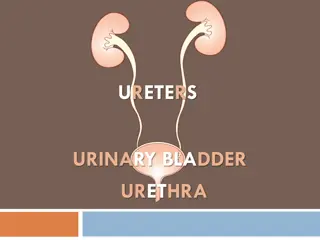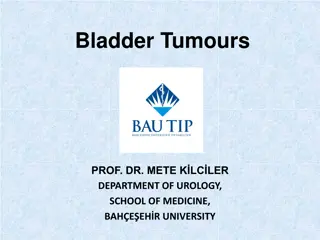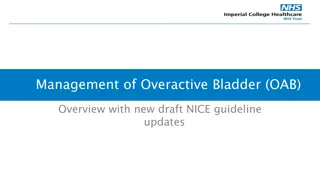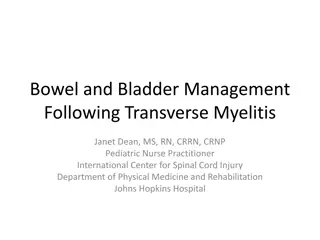
Bladder Cancer Staging and Diagnosis
Explore the intricacies of bladder cancer staging and diagnosis, from TURBT procedures to high-grade CIS detection. Uncover the significance of tumor grades and lymph node involvement in treatment decision-making. Discover the role of imaging techniques and biomarker tests in identifying bladder cancer progression.
Download Presentation

Please find below an Image/Link to download the presentation.
The content on the website is provided AS IS for your information and personal use only. It may not be sold, licensed, or shared on other websites without obtaining consent from the author. If you encounter any issues during the download, it is possible that the publisher has removed the file from their server.
You are allowed to download the files provided on this website for personal or commercial use, subject to the condition that they are used lawfully. All files are the property of their respective owners.
The content on the website is provided AS IS for your information and personal use only. It may not be sold, licensed, or shared on other websites without obtaining consent from the author.
E N D
Presentation Transcript
. - :
(1) 4 10 33% 1985 2000 80% : 90% : 75% S.hematobium www.ioanninamed.gr 3
(2) / = 3/1 : 68 70,500 2010 14,500 www.ioanninamed.gr 4
(1) : nitrosamine, 2-napthylamine, 4- aminobiphenyl - ~50% : , , , , : RT , cyclophosphamide www.ioanninamed.gr 5
(2) : (p53) 17 -> high-grade Ca CIS p15 p16 9 -> low-grade Ca (Rb) EGFR erb-b2 p21 ras, c-myc c-jun www.ioanninamed.gr 6
(1) Tumor grade -> Ta, T1 CIS -> 2, 3, 4 -> CIS: , , : Low-grade (1-2) High-grade (3) www.ioanninamed.gr 9
(2) : 70% , 20% , 10% 25% -> 50% 5 5% LNs, , , , 25-30% LN LN 5 www.ioanninamed.gr 11
(1) : TURBT : (-) low-grade (+) 1-12% 95% high-grade CIS (+) -> www.ioanninamed.gr 12
(2) ( ) high-grade : CT MRI TURBT : , , CT , TURBT-EUA: Scanning ALP www.ioanninamed.gr 13
(3) : BTA, NMP-22, FDP FISH: 3, 7, 17 9p21 www.ioanninamed.gr 14
(1) Stage I ( ) TUR , low-risk 24hrs NCCN intermediate-risk BCG high-risk <=> 2 TUR (IIB) (IIIB) BCG NCCN mytomycin high-grade 1 BCG CIS -> www.ioanninamed.gr 16
(2) High-grade TURBT (N0 CTs): neoadjuvant 2 www.ioanninamed.gr 17
(3) RT -> ) ) PS: TURBT RT 2 3a ) , ) , ) , ) ) : TUR, TUR , RT, RT www.ioanninamed.gr 19
(4) -> , , o LN , CIS , , , , LN , 25% LN , PLND www.ioanninamed.gr 20
(5) : / : -> (pouch) Indiana pouch Koch pouch , , , , - , - - www.ioanninamed.gr 21
Neoadjuvant: PS>2 carboplatin taxane-based -> , neoadjuvant, adjuvant 2 CAP MVAC MVEC -> 3 cisplatin-based MVAC ( Grossman et al. ) gemcitabine- cisplatin (GC) - (<50% ) www.ioanninamed.gr 24
RT - ERBT 5 20-40% 90% 2- 3 Neoadjuvant ERBT www.ioanninamed.gr 25
5 : = 82-100% T2 = 63-83% 3a = 67-71% 3b = 17-57% T4 = 0-22% 2 : 5% : p53 -> ( 1/ 2/ 3) CIS 2 www.ioanninamed.gr 28
J Clin Oncol. 1994 Jul;12(7):1394-401. Neoadjuvant chemotherapy for invasive bladder cancer: prognostic factors for survival of patients treated with M-VAC with 5-year follow-up. Schultz PK, Herr HW, Zhang ZF, Bajorin DF, Seidman A, Sarkis A, Fair WR, Scherr D, Bosl GJ, Scher HI. Department of Medicine, Memorial Sloan-Kettering Cancer Center, New York, NY 10021. Comment in: J Clin Oncol. 1995 Jan;13(1):300-2. Abstract PURPOSE: To determine survival in patients with muscle-invasive bladder cancer treated with neoadjuvant chemotherapy and to analyze prechemotherapy and postchemotherapy factors for prognostic significance. PATIENTS AND METHODS: The survival of 111 patients with T2-4N0M0 bladder cancer treated with neoadjuvant methotrexate, vinblastine, doxorubicin, and cisplatin (M-VAC) was assessed. Prechemotherapy and postchemotherapy factors were analyzed for correlation with survival. Factors found to be significant on univariate analysis were subjected to multivariate analysis using Cox's proportional hazards model. RESULTS: The median follow-up duration was 5.3 years. Initial tumor (T) stage (P = .0001), presence of ureteral obstruction (P = .0074), and presence of a palpable mass (P = .0039) were the only pretreatment factors found to be significant on univariate analysis. Postchemotherapy surgery was performed in 81 patients. In these cases, postchemotherapy clinical stage and pathologic stage were significant factors on univariate analysis. In the multivariate analysis, the initial prechemotherapy T stage and the postchemotherapy pathologic stage (pT stage) were the only two factors to demonstrate independent significance. An association between downstaging postchemotherapy and survival was observed for patients with extravesical disease (T < or = 3B) at the start of treatment. In this subset, the 5-year survival rate was 54% for patients with downstaging versus 12% for those without downstaging. This association was not observed for patients with bladder-confined disease (T < or = 3A) at presentation. CONCLUSION: The stage of bladder cancer at presentation and at postchemotherapy pathologic staging are independent prognostic factors for long-term survival in patients treated with neoadjuvant chemotherapy. Downstaging after neoadjuvant chemotherapy was associated with improved survival in patients with muscle-invasive bladder cancers, but only for those with extravesical disease (T > or = 3B) pretreatment. Randomized comparisons will be required to assess the impact of chemotherapy on overall survival. www.ioanninamed.gr 29
J Clin Oncol. 1996 Nov;14(11):2901-7. Improved local control of invasive bladder cancer by concurrent cisplatinand preoperative or definitive radiation. The National Cancer Institute of Canada Clinical Trials Group. Coppin CM, Gospodarowicz MK, James K, Tannock IF, Zee B, Carson J, Pater J, Sullivan LD. British Columbia Cancer Agency Vancouver Cancer Centre, Canada. ccoppin@bccancer.bc.ca Abstract PURPOSE: A prospective randomized trial was conducted to determine whether the addition of concurrent cisplatin to preoperative or definitive radiation therapy in patients with muscle-invasive bladder cancer improved local control or survival. PATIENTS AND METHODS: Ninety-nine eligible patients with T2 to T4b transitional cell bladder cancer participated, 64% with cT3b or cT4. Patients and their physicians selected either definitive radiotherapy or precystectomy radiotherapy; patients were then randomly allocated to receive intravenous cisplatin 100 mg/m2 at 2-week intervals for three cycles concurrent with pelvic radiation, or to receive radiation without chemotherapy. Patients were stratified by clinical tumor stage and by radiation plan. The median follow-up duration is 6.5 years. RESULTS: The occurrence of distant metastases was the same in both study arms. However, 25 of 48 control patients have had a first recurrence in the pelvis, compared with 15 of 51 cisplatin-treated patients (P = .036). The pelvic relapse rate in the two groups was significantly reduced by concurrent cisplatin (P = .038, log-rank test) and this effect was preserved in a stepwise Cox regression model of prognostic factors (hazards ratio, 0.50; 90% confidence interval [CI], 0.29 to 0.86; P = .036). The hazard reduction was similar for both radiation plans. Pretreatment leukocytosis and high clinical stage were independent adverse factors in a Cox model of overall survival, but the effect of cisplatin was not significant. CONCLUSION: Concurrent cisplatin may improve pelvic control of locally advanced bladder cancer with preoperative or definitive radiation, but has not been shown to improve overall survival. The use of concurrent cisplatin had no detectable effect on distant metastases. www.ioanninamed.gr 30
J Clin Oncol. 2011 Jan 4. [Epub ahead of print] Phase II Study of Conformal Hypofractionated Radiotherapy With Concurrent Gemcitabine in Muscle-Invasive Bladder Cancer. Choudhury A, Swindell R, Logue JP, Elliott PA, Livsey JE, Wise M, Symonds P, Wylie JP, Ramani V, SangarV, Lyons J, Bottomley I, McCaul D, Clarke NW, Kiltie AE, Cowan RA. The Christie NHS Foundation Trust, Manchester; The Royal Preston Hospital, Preston; Leicester Royal Infirmary, Leicester; and The Gray Institute for Radiation Oncology and Biology, Oxford, United Kingdom. Abstract PURPOSE The aim of this prospective, phase II trial was to determine the response of muscle-invasive bladder cancer (MIBC) to concurrent chemoradiotherapy of weekly gemcitabine with 4 weeks of radiotherapy (RT; GemX). PATIENTS AND METHODS Fifty patients with transitional cell carcinoma, stage T2-3, N0, M0 after transurethral resection and magnetic resonance imaging, were recruited. Gemcitabine was given intravenously at 100 mg/m(2) on days 1, 8, 15, and 22 of a 28-day RT schedule that delivered 52.5 Gy in 20 fractions. Chemotherapy was stopped for Radiation Therapy Oncology Group (RTOG) grade 3 bladder or bowel toxicity. The primary end points were tumor response, toxicity, and survival. Results All patients completed RT; 46 tolerated all four cycles of gemcitabine. Two patients stopped after two cycles, and two stopped after three cycles, because of bowel toxicity. Forty-seven patients had a post-treatment cystoscopy; 44 (88%) achieved a complete endoscopic response. At a median follow-up of 36 months (range, 15 to 62 months), 36 patients were alive, and 32 of these had a functional and intact bladder. Fourteen patients died; seven died as a result of metastatic MIBC, five died as a result of intercurrent disease, and two died as a result of treatment- associated deaths. Four patients underwent cystectomy; three because of recurrent disease and one because of toxicity. One patient required a bowel resection for late toxicity. By using Kaplan-Meier analyses, 3-year cancer-specific survival was 82%, and overall survival was 75%. CONCLUSION Concurrent gemcitabine-based chemoradiotherapy (ie, GemX) produces a high response rate in MIBC and has durable local control and acceptable toxicity, which allows patients to preserve their own bladder. This treatment modality warrants additional investigation in a phase III setting. www.ioanninamed.gr 31
J Clin Oncol. 2002 Jul 15;20(14):3061-71. Combined-modality treatment and selective organ preservation in invasive bladder cancer: long-term results. R del C, Grabenbauer GG, K hn R, Papadopoulos T, Dunst J, Meyer M, Schrott KM, Sauer R. Department of Radiation Oncology, Institute of Pathology, University of Erlangen, Germany. claus.roedel@strahlen.med.uni- erlangen.de Comment in: J Clin Oncol. 2003 Aug 1;21(15):3003; author reply 3003-4. J Clin Oncol. 2002 Jul 15;20(14):3048-50. Abstract PURPOSE: To evaluate our long-term experience with combined modality treatment and selective bladder preservation and to identify factors that may predict treatment response, risk of relapse, and survival. PATIENTS AND METHODS: Between 1982 and 2000, 415 patients with bladder cancer (high-risk T1, n = 89; T2 to T4, n = 326) were treated with radiotherapy (RT; n = 126) or radiochemotherapy (RCT; n = 289) after transurethral resection (TUR) of the tumor. Six weeks after RT/RCT, response was evaluated by restaging-TUR. In case of complete response (CR), patients were observed at regular intervals. In case of persistent or recurrent invasive tumor, salvage-cystectomy was recommended. Median follow-up was 60 months (range, 6 to 199 months). RESULTS: CR was achieved in 72% of patients. Local control after CR without muscle-invasive relapse was maintained in 64% of patients at 10 years. Distant metastases were diagnosed in 98 patients with an actuarial rate of 35% at 10 years. Ten-year disease- specific survival was 42%, and more than 80% of survivors preserved their bladder. Early tumor stage and a complete TUR were the most important factors predicting CR and survival. RCT was more effective than RT alone in terms of CR and survival. Salvage cystectomy for local failure was associated with a 45% disease-specific survival rate at 10 years. Cystectomy because of a contracted bladder was restricted to 2% of patients. CONCLUSION: TUR with RCT is a reasonable option for patients seeking an alternative to radical cystectomy. Ideal candidates are those with early-stage and unifocal tumors, in whom a complete TUR is accomplished. www.ioanninamed.gr 32
Association Between the Number of Dissected Lymph Nodes During Pelvic Lymphadenectomyand Cancer-Specific Survival in Patients with Lymph Node- Negative Urothelial Carcinoma of the Bladder Undergoing Radical Cystectomy; May M, Herrmann E, Bolenz C, Brookman-May S, Tiemann A, Moritz R, Fritsche HM, Burger M, Trojan L, Michel MS, W lfing C, M ller SC, Ellinger J, Buchner A, Stief CG, Tilki D, Wieland WF, Gilfrich C, H fnerT, Hohenfellner M, Haferkamp A, Roigas J, Zacharias M, Bastian PJ; Annals of Surgical Oncology (Jan 2011) BACKGROUND: A larger number of dissected lymph nodes (LN) during pelvic lymphadenectomy in patients with muscle-invasive transitional-cell carcinoma of the bladder treated by radical cystectomy (RC) is crucial for exact tumor staging and is associated with a positive oncological outcome. METHODS: Clinical and pathological records of 1291 patients undergoing RC due to LN-negative transitional-cell carcinoma of the bladder were summarized and evaluated in a multi-institutional database. The number of removed LNs and the presence or absence of lymphovascular invasion were assessed. On the basis of multivariate Cox regression analyses, a threshold number of removed LNs was defined that exerted an independent influence on cancer-specific survival (CSS). RESULTS: In multivariate Cox regression models for different numbers of removed LNs, a statistically significant enhancement of CSS could be demonstrated for a LN count of 16. Furthermore, the integration of the dichotomized LN count of 16 resulted in a statistically significantly enhanced predictive ability of the model for CSS. Patients with<16 and 16 removed LNs showed CSS rates after 5 years of 72% and 83%, respectively (P = 0.01). In addition, age, sex, pT stage, and lymphovascular invasion had independent influences on CSS in every Cox regression model. CONCLUSIONS: In patients undergoing RC, removal of a higher LN count is associated with an improved oncological outcome. The information resulting from an assessment of lymphovascular invasion and an extended lymphadenectomy is critical for stratification of risk groups and identification of patients who might benefit from adjuvant treatment. www.ioanninamed.gr 33
J Clin Oncol. 1997 Mar;15(3):1022-9. Bladder preservation by combined modality therapy for invasive bladder cancer. Kachnic LA, Kaufman DS, Heney NM, Althausen AF, Griffin PP, Zietman AL, Shipley WU. Department of Radiation Oncology, Massachusetts General Hospital, Harvard Medical School, Boston 02114, USA. Abstract PURPOSE: To update the efficacy of a selective multimodality bladder-preserving approach by transurethral resection (TURBT), systemic chemotherapy, and radiation therapy. PATIENTS AND METHODS: From 1986 through 1993, 106 patients with muscle-invading clinical stage T2 to T4a,Nx,M0 bladder cancer were treated with induction by maximal TURBT and two cycles of chemotherapy (methotrexate, cisplatin, vinblastine [MCV]) followed by 39.6-Gy pelvic irradiation with concomitant cisplatin. Patients with a negative postinduction therapy tumor site biopsy and cytology (a T0 response, 70 patients) plus those with less than a T0 response but medically unfit for cystectomy (six patients), received consolidative chemoradiation to a total of 64.8 Gy. Surgical candidates with less than a T0 response (13 patients) and patients who could not tolerate the chemoradiation (six patients) went to immediate cystectomy. The median follow-up duration is 4.4 years. RESULTS: The 5-year actuarial overall survival and disease-specific survival rates of all patients are 52% and 60%, respectively. For clinical stage T2 patients, the actuarial overall survival rate is 63%, and for T3-4, 45%. Thirty-six patients (34%) underwent cystectomy, all with evidence of tumor activity, including 17 with an invasive recurrence. The 5-year overall survival rate with an intact functioning bladder is 43%. Among 76 patients who completed bladder-preserving therapy, the 5-year rate of freedom from an invasive bladder relapse is 79%. No patient required cystectomy for treatment- related bladder morbidity. CONCLUSION: Combined modality therapy with TURBT, chemotherapy, radiation, and selection for organ-conservation by response has a 52% overall survival rate. This result is similar to cystectomy- based studies for patients of similar age and clinical stages. The majority of the long-term survivors retain fully functional bladders. www.ioanninamed.gr 34
Can Urol Assoc J. 2011 Jan 13. doi: 10.5489/cuaj.09118. [Epub ahead of print] Screening and identification of specific markers for bladder transitional cell carcinoma from urine urothelial cells with suppressive subtractive hybridization and cDNA microarray. Guo B, Che T, Shi B, Guo L, Yin Y, Li L, Wang J, Yan D, Chen Y. The First Affiliated Hospital of Lanzhou University, Lanzhou, China. Abstract OBJECTIVE: The objective of this study was to screen and identify differentially expressed genes in invasive bladder transitional cell carcinoma (BTCC). METHODS: Voided urine samples were collected from consecutive patients with BTCC and patients under surveillance for bladder cancer recurrence; voided urine samples from patients with non-malignant diseases served as control. We identified the differentially expressed genes by comparing urine samples of bladder carcinoma to that of the control group with suppressive subtractive hybridization (SSH) and cDNA microarray. The differentially expressed genes were verified by quantitative real-time polymerase chain reaction (QPCR). RESULTS: From the 762 white colonies, a total of 449 positive clones were obtained in which 112 were found to be upregulated in BTCC. Sequencing and homology analysis were performed for these 112 clonies. The detection rates of some known genes (including IGF-1, human telomerase reverse transcriptase [hTERT], bladder cancer specific nuclear matrix protein 4 [BLCA-4] and homeobox A13 [HOXA13]) for BTCC at the Ta, T1 and >T1 stages were 48%, 90% and 100%, respectively, with a specificity of 85%. The test specificity was 80% for the 30 control patients with urinary tract infections. The combination of BLCA-4 and HOXA13 could distinguish between low-and high-grade tumours, with specificity and sensitivity of 80%. CONCLUSION: We successfully constructed a reliable SSH library of BTCC and found that combination detection insulin-like growth factor 1 (IGF-1), hTERT, BLCA-4 and HOXA13 genes could help to evaluate BTCC at different stages. www.ioanninamed.gr 35
FGFR3, HRAS, KRAS, NRAS and PIK3CA Mutations in Bladder Cancer and Their Potential as Biomarkers for Surveillance and Therapy Lucie C. Kompier1, Irene Lurkin1, Madelon N. M. van derAa1, Bas W. G. van Rhijn2, Theo H. van der Kwast3, Ellen C. Zwarthoff1 Department of Pathology, Erasmus MC, Rotterdam, The Netherlands, 2 Department of Urology, University Health Network, Toronto General Hospital, Toronto, Canada, 3 Department of Laboratory Medicine and Pathobiology, University Health Network, Toronto General Hospital, Toronto, Canada Abstract Background Fifty percent of patients with muscle invasive bladder cancer (MI-BC) die from their disease and current chemotherapy treatment only marginally increases survival. Novel therapies targeting receptor tyrosine kinases or activated oncogenes may improve outcome. Hence, it is necessary to stratify patients based on mutations in relevant oncogenes. Patients with non-muscle-invasive bladder cancer (NMI-BC) have excellent survival, however two-thirds develop recurrences. Tumor specific mutations can be used to detect recurrences in urine assays, presenting a more patient-friendly diagnostic procedure than cystoscopy. Methodology/Principal Findings To address these issues, we developed a mutation assay for the simultaneous detection of 19 possible mutations in the HRAS, KRAS, and NRAS genes. With this assay and mutation assays for the FGFR3 and PIK3CA oncogenes, we screened primary bladder tumors of 257 patients and 184 recurrences from 54 patients. Additionally, in primary tumors p53 expression was obtained by immunohistochemistry. Of primary tumors 64% were mutant for FGFR3, 11% for RAS, 24% for PIK3CA, and 26% for p53. FGFR3 mutations were mutually exclusive with RAS mutations (p = 0.001) and co- occurred with PIK3CA mutations (p = 0.016). P53 overexpression was mutually exclusive with PIK3CA and FGFR3 mutations (p 0.029). Mutations in the RAS and PIK3CA genes were not predictors for recurrence-free, progression- free and disease-specific survival. In patients presenting with NMI-BC grade 3 and MI-BC, 33 and 36% of the primary tumors were mutant. In patients with low-grade NMI-BC, 88% of the primary tumors carried a mutation and 88% of the recurrences were mutant. Conclusions/Significance The mutation assays present a companion diagnostic to define patients for targeted therapies. In addition, the assays are a potential biomarker to detect recurrences during surveillance. We showed that 88% of patients presenting with low-grade NMI-BC are eligible for such a follow-up. This may contribute to a reduction in the number of cystoscopical examinations. www.ioanninamed.gr 36
Eur Urol. 2011 Jan 18. [Epubahead of print] Maximizing Cure for Muscle-Invasive Bladder Cancer: Integration of Surgery and Chemotherapy. FeiferAH, Taylor JM, Tarin TV, Herr HW. Department of Urology, Memorial Sloan-Kettering Cancer Center, New York, NY, USA. Abstract CONTEXT: The optimal treatment strategy for muscle-invasive bladder cancer remains controversial. OBJECTIVE: To determine optimal combination of chemotherapy and surgery aimed at preserving survival of patients with locally advanced bladder cancer. EVIDENCE ACQUISITION: We performed a critical review of the published abstract and presentation literature on combined modality therapy for muscle-invasive bladder cancer. We emphasized articles of the highest scientific level, combining radical cystectomyand perioperativechemotherapy with curative intent to affect overall and disease-specific survival. EVIDENCE SYNTHESIS: Locally invasive, regional, and occult micrometastases at the time of radical cystectomy lead to both distant and local failure, causing bladder cancer deaths. Neoadjuvant and adjuvant chemotherapy regimens have been evaluated, as well as the quality of cystectomy and pelvic lymph node dissection. CONCLUSIONS: Prospective, randomized clinical trials argue strongly for neoadjuvant cisplatin-based chemotherapy followed by high-quality cystectomy performed by an experienced surgeon operating in a high-volume center. Adjuvant chemotherapy after surgery is also effective when therapeutic doses can be given in a timely fashion. Both contribute to improved overall survival; however, many patients receive only one or none of these options, and the barriers to receiving optimal, combined, systemic therapy and surgery remain to be defined. An aging, comorbid, and often unfit population increasingly affected by bladder cancer poses significant challenges in management of individual patients. www.ioanninamed.gr 37
J Urol. 2011 Jan;185(1):72-8. Epub 2010 Nov 12. Treatment of muscle invasive bladder cancer: evidence from the National Cancer Database, 2003 to 2007. Fedeli U, Fedewa SA, Ward EM. Epidemiological Department, Veneto Region, Castelfranco Veneto, Italy. Abstract PURPOSE: We describe nationwide treatment patterns of muscle invasive bladder cancer, investigated determinants of cystectomy and provide contemporary trends in process of care measures in patients undergoing cystectomy. MATERIALS AND METHODS: We selected 40,388 patients 18 to 99 years old diagnosed with muscle invasive (stages II to IV) bladder cancer in 2003 to 2007 from the National Cancer Database. Treatment included cystectomy, neoadjuvant and adjuvant chemotherapy, chemotherapy without surgery and radiation therapy. In patients undergoing cystectomy we retrieved the procedure type (partial vs radical), lymphadenectomy extent and 30-day followup. Cystectomy determinants were assessed by Poisson regression with robust error variance. Perioperative mortality was analyzed by multilevel logistic regression. RESULTS: The proportion of patients treated with cystectomy (42.9%) and radiation therapy (16.6%) remained stable with time while the incidence of those who received chemotherapy increased from 27.0% in 2003 to 34.5% in 2007 due to an increase in neoadjuvant chemotherapy and chemotherapy without surgery. The cystectomy rate decreased with age and was lower in racial/ethnic minorities (especially black patients), uninsured or Medicaid patients, patients residing in the South and Northeast, and those treated at nonteaching/research hospitals. The partial cystectomy rate decreased and lymphadenectomy extent increased with time. The perioperative mortality rate was 2.6% and it was higher at low vsvery high volume hospitals (OR 1.71, 95% CI 1.26-2.32). CONCLUSIONS: Recent nationwide data confirm ongoing improvements in process of care measures in patients who undergo cystectomy but also show marked differences in treatment patterns for muscle invasive bladder cancer by patient age, race, insurance status, geographic area and facility type. www.ioanninamed.gr 38






















